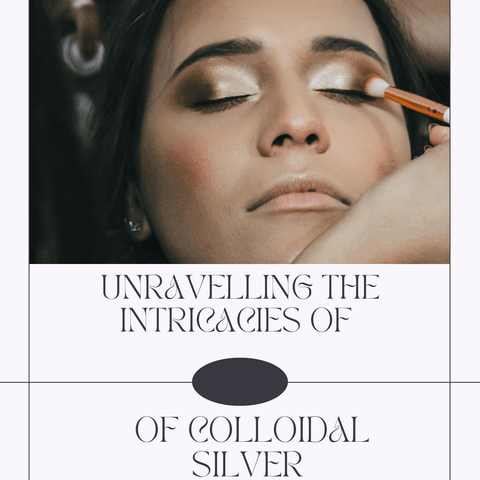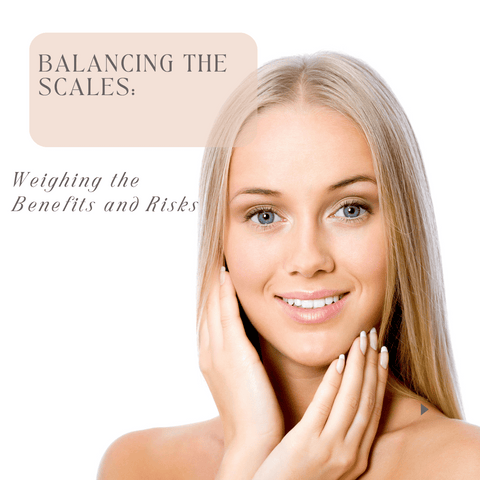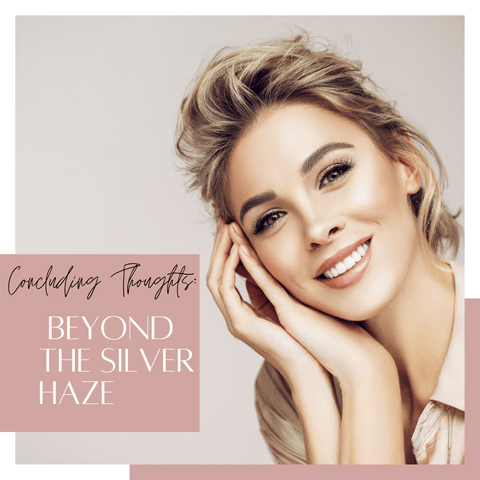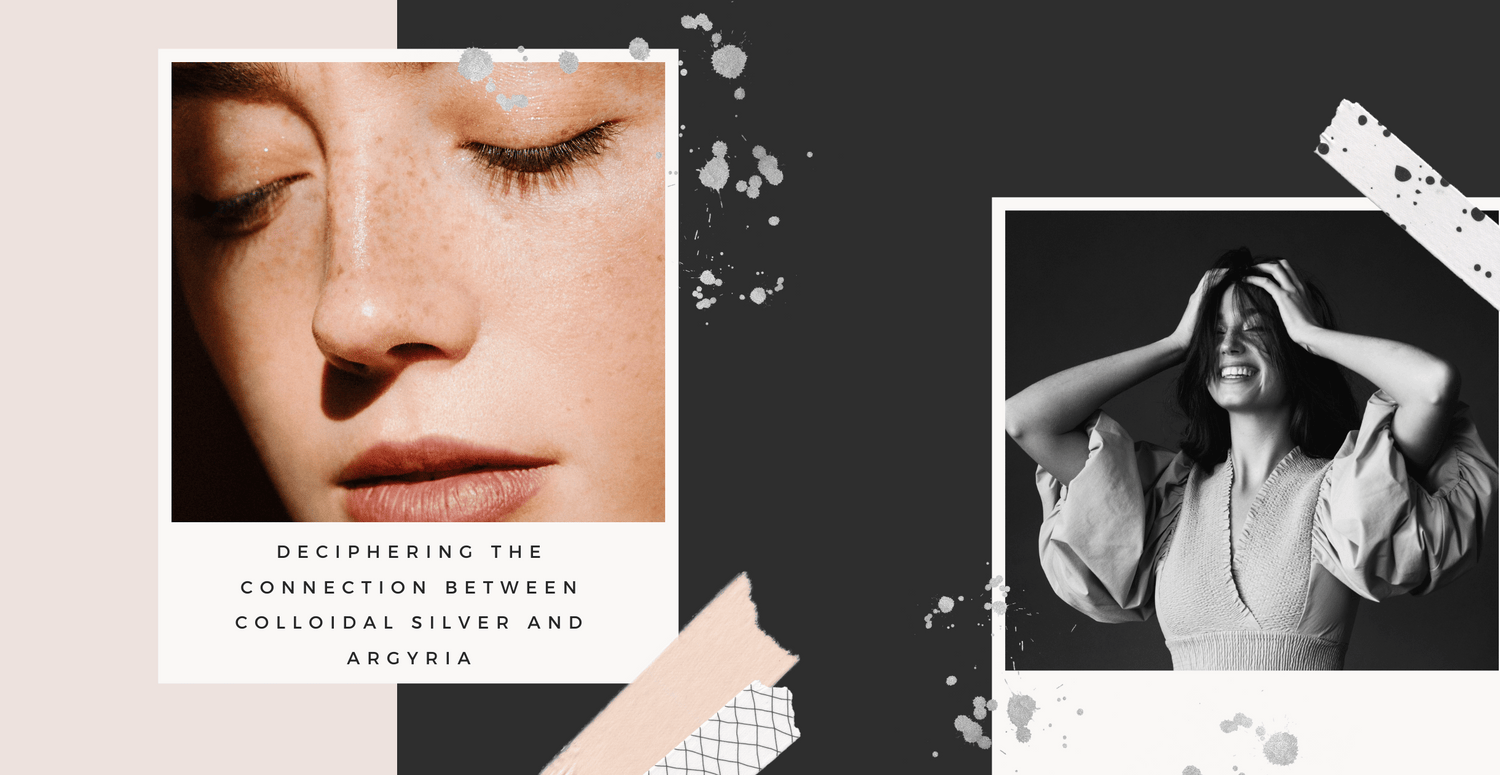Colloidal silver is a liquid suspension of submicroscopic silver particles. It has historically been used as an antimicrobial agent due to its alleged antibacterial and antifungal qualities. However, the use of colloidal silver as a health supplement has been controversial, and neither scientific consensus nor regulatory bodies such as the United States Food and Drug Administration (FDA) approve it. One of the most serious risks associated with colloidal silver use is argyria. Argyria is a rare and permanent skin discoloration caused by silver particle accumulation in the skin, giving it a bluish-gray appearance. The primary cause of this syndrome is excessive and prolonged ingestion of colloidal silver or other types of silver compounds. The specific mechanism by which argyria develops involves the deposition of silver particles in the skin and other tissues, which can result in an extremely agonising cosmetic disfigurement.
It is important to note that argyria is not linked to the safe use of silver in medical treatments like silver-based wound dressings or medical devices. It is instead related to the use of colloidal silver solutions, which are frequently marketed as dietary supplements. These products may have inconsistencies in silver concentrations, and their safety and efficacy are not supported by rigorous scientific research. Because of the lack of scientific evidence supporting its health benefits and potential risks, such as argyria, the medical community generally discourages the use of colloidal silver as a dietary supplement. If you want to use silver for medical purposes, consult a doctor first and stick to treatments that are supported by well-established scientific research and medical guidelines.
Unravelling the Intricacies of Colloidal Silver

Colloidal silver is a suspension of microscopic silver particles in a liquid media, typically water, that range in size from nanometers to micrometres. Electrical charges on their surfaces keep these particles suspended and prevent them from clumping together. Preparation, particle size, the Tyndall effect, antibacterial characteristics, health claims and debate, argyria, regulation, and scientific examination are some crucial elements to help understand the complexities of colloidal silver. While silver does have antibacterial qualities, its use as a health supplement is debatable due to potential hazards such as argyria and a lack of sufficient scientific data supporting its usefulness. If you're thinking about taking colloidal silver for any reason, talk to a doctor first and stick to evidence-based treatments.
Historical Context: Colloidal Silver's Ancient Use
For thousands of years, silver has been used for its antibacterial qualities. Various civilizations and cultures have used silver in various forms to battle diseases and aid healing. Here's a look at the historical context of silver's use, including ancient civilizations, the mediaeval period, cutlery, silver nitrate, silver sulfadiazine, modern medicine, and the rebirth of colloidal silver. While the historical use of silver shows that metal may have antibacterial characteristics, it is crucial to emphasise that ancient practices were frequently based on observations rather than a thorough grasp of microbiology. Modern antibiotics and other medical advances have resulted in more tailored and evidence-based methods for infection prevention and treatment. The historical setting highlights the long-standing fascination with silver's possible health and hygiene benefits. However, given the possible hazards connected with excessive silver use, it is vital to approach such practices with a critical and evidence-based mindset.
Benefits: The Therapeutic Value of Silver
Silver's potential medicinal benefit, particularly its antibacterial characteristics, has been recognised. While the use of silver as a health remedy has historical roots and anecdotal evidence, the scientific community generally emphasises the importance of comprehensive studies to establish the safety and efficacy of silver-based treatments. The following are some areas where silver's medicinal potential has been investigated:
-
Antimicrobial Properties: Silver ions have been shown to inhibit a wide range of microbes, including bacteria, fungi, and viruses. Infections have a harder time surviving and spreading because silver messes with how microbial cell membranes and enzymes function.
-
Wound Healing: Silver has been used to treat wounds, burns, and ulcers in a variety of forms (such as silver sulfadiazine and silver-containing dressings). These products are thought to aid in the prevention of infections, the promotion of healing, and the reduction of inflammation.
-
Medical devices and catheters: Silver-coated catheters and implants are made to lower the chance of infection brought on by the device. The antibacterial properties of silver can be helpful by preventing the growth of biofilms (bacterial colonies) on these devices.
-
Dental Applications: Silver compounds have been used in dentistry, including dental amalgams (silver fillings) and silver diamine fluoride, which can be used to treat hypersensitivity and prevent tooth decay.
-
Water purification: To disinfect drinking water, regulate bacterial growth, and stop the spread of waterborne diseases, silver's antimicrobial properties have been used in water purification systems.
-
Treatment with an antifungal agent: Some research has looked into the ability of silver to treat fungi that cause nail infections and athlete's foot.
-
Infections associated with implants: Studies have looked at the use of silver nanoparticles to lower the risk of infections associated with surgical implants, such as joint replacements.
-
Respiratory Infections: Silver-containing products have been marketed as treatments for respiratory infections, such as colloidal silver solutions or nasal sprays, but the scientific community questions their efficacy.
Due to the potential hazards and uncertainties, it is vital to approach the therapeutic use of silver with caution and critical consideration. While silver has shown antibacterial qualities in the laboratory, converting these properties into safe and effective treatments necessitates careful consideration of issues such as dosage, delivery mechanisms, and potential adverse effects. Furthermore, the utility of colloidal silver as a dietary supplement or alternative medicine therapy is highly debated. There is inadequate data to support its usage for treating numerous health disorders, and the possibility of argyria and other deleterious consequences linked with excessive silver consumption is a concern.
Potential Risks: Understanding Silver Toxicity
Silver toxicity is the detrimental effect that can occur when large amounts of silver are consumed, inhaled, or come into contact with the body for an extended length of time. While silver has antibacterial characteristics and possible therapeutic applications, it is critical to understand the hazards associated with silver exposure:
-
Argyria: One of the most well-known risks of silver exposure is argyria, a condition in which the skin and mucous membranes appear bluish-gray due to silver particle deposition. Long-term and excessive silver intake, most commonly from colloidal silver products, is a common cause of argyria. Although the condition is usually transient and cosmetic, with no serious health consequences, it can be upsetting mentally.
-
Argyrosis: Argyrosis, like argyria, is caused by the deposition of silver in the conjunctiva and cornea of the eye, resulting in a bluish-gray discoloration. It can have an effect on vision and eye health.
-
Silver Particle Accumulation in Other Organs: Excessive silver exposure can cause silver particle accumulation in other organs such as the liver, kidneys, and brain. This has the potential to interfere with normal organ functions.
-
Neurological Effects: Some research has suggested a link between high silver exposure and neurological symptoms such as cognitive impairments and behavioral changes. More research, however, is required to establish a clear cause-and-effect relationship.
-
Gastrointestinal Distress: Ingesting large amounts of silver can lead to gastrointestinal issues such as nausea, vomiting, abdominal pain, and diarrhea.
-
Allergic Reactions: Some people are allergic to silver, especially if they come into direct contact with silver-containing products.
-
Interaction with Medications: Silver has the potential to interact with certain medications, reducing their effectiveness or causing adverse reactions.
-
Drug Resistance: Excessive use of silver-based antimicrobial agents may contribute to the development of antimicrobial resistance, in which microbes become less responsive to treatment.
-
Long-Term Effects Are Unknown: The long-term effects of consistent low-level exposure to silver nanoparticles, which are increasingly used in a variety of consumer products, are not fully understood.
To reduce the risks associated with silver exposure, it is critical to:
-
Avoid using colloidal silver or other silver-based products as dietary supplements or alternative remedies without first consulting a healthcare professional.
-
Follow the guidelines and recommendations for the safe use of silver-containing medical products, such as wound dressings or medical devices.
-
Silver-containing personal care products should be approached with caution, especially if their safety and effectiveness are not supported by credible scientific research.
-
Seek medical attention if you suspect you are experiencing silver-related symptoms or if you have concerns about a silver-containing product.
Remember that, while silver has antimicrobial properties, there are more established and evidence-based treatments for a variety of health conditions. If you require medical attention, seek out treatments that are backed by extensive scientific research and accepted medical practises.
The Enigma of Argyria: Separating Myth from Reality

Argyria is a condition characterised by bluish-gray staining of the skin and mucous membranes caused by a buildup of silver particles in the body. It has received a great deal of attention due to its association with the use of colloidal silver and other silver-containing products. Let us separate the myths from the facts about argyria:
-
Myth 1: Argyria is Harmless and Only Cosmetic Reality: While argyria is generally considered harmless from a medical standpoint and does not usually cause serious health issues, saying it is harmless is not entirely accurate. Although argyria is primarily a cosmetic problem, the psychological and social consequences of visible skin discoloration can be significant. Furthermore, the accumulation of silver particles in various tissues raises concerns about potential long-term effects, despite the lack of conclusive evidence.
-
Myth 2: Argyria is Common Reality: Argyria is actually quite rare. The majority of people who use silver-containing products, even for long periods of time, do not develop argyria. Silver consumption that is prolonged and excessive is usually required for the condition to develop.
-
Myth 3: Any Form of Silver Can Cause Argyria Reality: The risk of developing argyria is related to the type of silver used, the size of the particles, and the method of exposure. Colloidal silver products, particularly those containing larger silver particles, are more likely to cause argyria due to their ability to accumulate in the body. Silver exposure to dietary supplements and certain alternative health products is more dangerous than silver exposure from everyday items like silverware.
-
Myth 4: Argyria Can Be Easily Reversed Reality: Argyria is generally thought to be irreversible. The silver particles become embedded deep within the skin and other tissues, making removal difficult. Various treatments, such as lasers and creams, have been tried, but their efficacy has been limited and they are not widely accepted.
-
Myth 5: Argyria is an Allergic Reaction Reality: Argyria is not an allergic reaction. The deposition of silver particles causes a physical change in the color of the skin and tissues. The immune system responds to substances to cause allergic reactions, whereas silver particles directly interact with skin tissues to cause argyria.
-
Myth 6: Colloidal Silver is Safe for Consumption Reality: The safety of colloidal silver for human consumption is debatable. Regulatory agencies such as the United States Food and Drug Administration have expressed concerns about the safety and efficacy of colloidal silver products, particularly when used as dietary supplements. There is insufficient scientific evidence to support the health claims made by these products, and they may cause argyria and other side effects.
While argyria is not a life-threatening condition, it is vital to recognise that it is also not completely harmless. The scarcity of argyria should not be used to disregard the possible dangers of excessive use of silver-containing goods. When considering the use of silver for health, it is best to consult with a healthcare practitioner and rely on therapies that are backed up by solid scientific evidence.
Defining Argyria: More Than Just Skin Discoloration
Argyria is more than just skin darkening, you're right. While the bluish-gray hue that affects the skin and mucous membranes is the most visible sign of argyria, it's vital to understand that this disorder involves the accumulation of silver particles in many tissues throughout the body. Beyond visual discoloration, this accumulation can have the following consequences:
-
Skin Discoloration: The bluish-gray staining of the skin, nails, and mucous membranes is the most obvious indication of argyria. The level and intensity of the discoloration might vary based on the person, the amount of silver exposed, and other circumstances.
-
Internal Tissue Deposits: Silver particles can accumulate in internal organs such as the liver, kidneys, and brain. While the health implications of this accumulation are unknown, it raises concerns about potential effects on organ function and long-term health.
-
Eye Involvement: Argyria can affect the eyes, causing a bluish-gray discoloration of the conjunctiva and cornea. This can have an effect on vision and eye health.
-
Long-Term Effects: Despite the fact that silver accumulation in tissues is primarily considered a cosmetic condition, the long-term effects of silver accumulation in tissues are not well-documented. Some research has suggested that there may be neurological and cognitive effects, but more research is needed to establish any causal relationships.
-
Psychosocial Impact: Having skin that is visibly discolored can have serious psychological and social repercussions. A person with argyria might feel anxious, and self-conscious, and have a lower quality of life because of their appearance.
-
Treatment Difficulties: Argyria is generally thought to be irreversible, and treatments aimed at reducing skin discoloration are often ineffective. This can be aggravating for people looking for solutions to their appearance-related problems.
-
Differential Diagnosis: Argyria is sometimes confused with other skin conditions or health problems. A correct diagnosis is critical for dealing with any underlying medical issues and delivering appropriate information to individuals affected by the disease.
It is critical to approach the subject of argyria with caution, as it can have serious bodily and mental consequences for individuals. While the medical profession frequently underlines that argyria is not a life-threatening condition, it is also crucial to recognise the potential hazards of silver exposure and the unknowns surrounding its long-term effects. Given the rarity of argyria and the potential for substantial psychosocial damage, education, awareness, and evidence-based recommendations are critical for people who are thinking about using silver-containing products for health reasons. Healthcare experts can offer knowledgeable advise and assist clients in making decisions that prioritise their health.
Potential Causes: Is Colloidal Silver to Blame?
Yes, colloidal silver is one of the leading causes of argyria. The primary cause of argyria is excessive and extended ingestion of silver, which is frequently in the form of colloidal silver solutions or other silver-containing products. Here's how colloidal silver can help with argyria:
-
Silver Accumulation: Colloidal silver solutions contain tiny silver particles suspended in a liquid medium. When these silver particles are consumed, they can be absorbed into the bloodstream and distributed throughout the body. Excessive consumption can result in the accumulation of silver particles in various tissues, including the skin, over time.
-
Particle Size: The size of the silver particles in colloidal silver is an important consideration. Larger particles are more likely to be visible in the skin, contributing to argyria's characteristic bluish-gray discoloration.
-
No Established Excretion Route: Unlike some other metals that the body can eliminate via natural processes, such as urine or bile, excess silver does not have a known excretion route. This means that once silver builds up in the body, removal can be difficult.
-
Lack of Regulation and Dosage Guidelines: Colloidal silver is frequently marketed as a dietary supplement or an alternative treatment, and it does not undergo the same stringent regulatory scrutiny as pharmaceutical drugs. This lack of regulation can result in variations in product quality and concentration, making it difficult for consumers to determine safe dosages.
-
Misguided Health Claims: Some colloidal silver product marketers make unsubstantiated health claims, claiming that the solution may treat a variety of medical ailments. This can lead to people consuming excessive amounts of colloidal silver in the mistaken belief that they are benefiting their health.
-
Ignorance of Risks: Many people may be unaware of the potential risks associated with colloidal silver consumption. They may believe that natural remedies are inherently safe and fail to recognise the possibility of negative consequences.
While colloidal silver is a well-known cause of argyria, not all forms of silver exposure result in this illness. Traditional medicinal uses of silver, such as silver-based wound dressings or medical gadgets, are subject to strict quality and safety requirements and are not related to the risk of argyria. If you're thinking about utilising silver-containing goods for health reasons, it's critical to talk with a doctor and make an informed decision based on evidence-based practices. Caution is advised due to the potential hazards and the lack of good scientific data supporting the health benefits of colloidal silver.
Medical Perspectives: What the Research Tells Us
Scientific research and clinical observations shape medical views on colloidal silver and argyria. Here's what the research says about colloidal silver use and its potential to cause argyria:
-
Lack of Robust Scientific Evidence: Despite colloidal silver's historical use as a health supplement and its antimicrobial properties, there are not enough well-designed clinical trials and solid scientific evidence to back it up. The majority of the research that is currently available consists of case studies, anecdotal evidence, and studies with methodological restrictions.
-
Risk of Argyria: The main worry with colloidal silver is that it might lead to argyria. The excessive and prolonged use of silver-containing products, including colloidal silver, has been linked to a number of reported cases of argyria. The size of the silver particles is particularly related to the risk of argyria, with larger particles being more likely to cause skin discoloration.
-
Different Dosages: Uncertainty regarding safe consumption levels of colloidal silver is exacerbated by the absence of standardised dosages and guidelines for its use. This lack of consistency makes determining what constitutes excessive use difficult.
-
Limited Health Claims: There is little scientific evidence to support many of the health claims made about colloidal silver. Credible scientific research does not back up claims that colloidal silver can treat a wide range of illnesses, such as cancer, serious infections, and HIV.
-
Regulatory Warnings: Health regulatory agencies, such as the United States Food and Drug Administration (FDA), have issued warnings about the potential risks associated with colloidal silver use. They advise against using these products due to a lack of evidence of efficacy and the risk of argyria and other side effects.
-
Alternative Antimicrobial Treatments: Modern medicine provides well-established and evidence-based treatments for infections and wounds. Antibiotics, antifungal agents, and antiseptics have long been used to combat microbial growth without causing argyria.
-
Silver in Medical Devices: Silver is used in certain medical devices and wound dressings that have been subjected to extensive testing and regulation. These applications are generally regarded as safe and effective for the purposes intended.
-
Ethical Considerations: Healthcare professionals stress the importance of evidence-based medicine and making informed decisions. Ethical concerns arise when people are led to believe that colloidal silver products can effectively treat serious illnesses in the absence of scientific evidence.
The medical community is wary of colloidal silver due to a lack of strong data supporting its health advantages and the potential hazards of argyria and other side effects. While silver has antibacterial qualities, there are more proven and safer options for treating infections and wounds. Individuals should seek the advice of a healthcare practitioner before using colloidal silver or other silver-containing products, especially for therapeutic purposes.
Balancing the Scales: Weighing the Benefits and Risks

Balancing the benefits and hazards of any medical intervention, including the use of colloidal silver, is critical for making informed health decisions. Here's how you can approach the issue of assessing the rewards and risks:
Benefits:
-
Antimicrobial Properties: Silver has been shown to possess antimicrobial qualities, and it has long been used to stop the spread of bacteria, fungi, and viruses.
-
Wound Healing: Silver-containing products have been utilised in wound care to aid in the prevention of infections and promote healing, particularly in cases of burns and persistent ulcers.
-
Medical Devices: Silver-coated medical devices are used to reduce the risk of infections associated with implants and catheters.
-
Water Purification: Silver's antimicrobial properties have been used to purify water, making it safer to drink.
Risks:
-
Argyria: Excessive and prolonged consumption of colloidal silver or other forms of silver can result in argyria, a condition characterised by bluish-gray skin discoloration. While argyria is generally thought to be harmless from a medical standpoint, it can have significant psychological and social consequences.
-
Lack of Scientific Evidence: There is no scientific evidence to support the health claims associated with colloidal silver. There is a scarcity of well-designed clinical trials to validate its efficacy for various conditions.
-
Variable Quality: The quality and concentration of colloidal silver products can vary, making determining safe dosages difficult for consumers.
-
Long-Term Effects Are Unknown: The long-term effects of silver accumulation in tissues are unknown, and there are concerns about potential neurological effects and organ disruption.
-
Alternative Treatments: Traditional medical treatments, such as antibiotics and wound care protocols, provide evidence-based options for infection management and healing.
Decision-Making Process:
-
Consult Healthcare Professionals
-
Consider Your Health Goals
-
Evaluate the Evidence
-
Assess Risk Tolerance
-
Explore Safer Alternatives
-
Critical Thinking
-
Consider the Placebo Effect
The decision to use colloidal silver or any silver-containing product should be guided by expert medical advice, credible scientific research, and a thorough examination of both the potential benefits and risks.
Safe Usage: Tips for Ensuring Skin Health
If you are thinking about using silver-containing products for topical application or wound care, such as colloidal silver, prioritise skin health and safety. Here are some precautions to take to ensure safe use:
-
Consult a Healthcare Professional: Before attempting to use any new product on your skin, speak with a dermatologist or other healthcare provider. They can advise you on whether the product is suitable for your skin type and condition.
-
Patch Test: Before applying any silver-containing product to a larger area of your skin, perform a patch test. Apply a small amount to a small, inconspicuous area and monitor for any adverse reactions or irritation for 24-48 hours.
-
Choose Quality Products: If you decide to use a silver-containing product, look for reputable brands that follow quality standards. Look for products that have been thoroughly tested and approved for their intended application.
-
Follow Instructions: Carefully read and follow the manufacturer's instructions for application and usage. Avoid overusing the product or applying it more frequently than recommended.
-
Avoid Open Wounds: Do not apply silver-containing products to open wounds, cuts, or areas with broken skin. These items may cause irritation or slow wound healing.
-
Irritation: If you experience any redness, itching, burning, or other signs of irritation after using a silver-containing product, stop using it and consult a healthcare professional.
-
Consider Established Treatments: Before using silver-containing products for wound care, consult with a healthcare professional about established wound care protocols.
-
Be Cautious with DIY Products: Homemade colloidal silver or other DIY skincare products may have inconsistent concentrations and pose a higher risk of adverse effects.
-
Stay Informed: Stay up to date on the most recent information and research on the use of silver-containing products for skin health. Remember that medical knowledge evolves over time.
-
Discuss with your healthcare provider: Before using silver-containing products, discuss any pre-existing skin conditions, allergies, or concerns with your healthcare provider.
-
Prioritise Evidence-Based Treatments: Think about evidence-based treatments that have been recommended by medical professionals for your specific skin concern.
-
Balanced Approach: If you decide to use silver-containing topical products, do so in a balanced way. Avoid overuse and discontinue use if you experience any negative effects.
Remember that skin health is critical, so when adding new products to your skincare routine, prioritise safety and speak with healthcare specialists. If you have concerns about a specific silver-containing product, you should consult a dermatologist or medical professional.
A World of Alternatives: Other Skincare Solutions
There are numerous skincare solutions on the market that are backed by scientific research and have a proven safety record. Here are some alternatives to consider for various skincare issues:
-
Cleansing and Moisturising:
-
Gentle cleansers: Look for cleansers that are free of harsh chemicals and fragrances, as well as those that are appropriate for your skin type.
-
Moisturisers: To keep your skin hydrated, look for moisturizers that contain ingredients like hyaluronic acid, glycerin, and ceramides.
-
Acne Treatment:
-
Benzoyl peroxide: A topical treatment for mild to moderate acne.
-
Salicylic acid: Helps to unclog pores and reduce inflammation in acne-prone skin.
-
Retinoids: Topical medications that reduce acne by clearing clogged pores and accelerating cell renewal.
-
Anti-Aging:
-
Retinoids: Prescription retinoids can assist in the reduction of fine lines and wrinkles.
-
Vitamin C serums: Vitamin C is an antioxidant that can improve skin texture and brightness.
-
Sunscreen: Using a broad-spectrum sunscreen on a daily basis is critical for preventing UV-induced premature aging.
-
Sensitive Skin:
-
Fragrance-free products: Avoid products with added fragrances, which can irritate sensitive skin.
-
Hypoallergenic products: Look for hypoallergenic and sensitive skin-friendly products.
-
Dry Skin:
-
Hydrating serums: Hyaluronic acid-containing serums can provide intense hydration.
-
Rich moisturisers: To lock in moisture, look for moisturisers that contain emollients like shea butter or ceramides.
-
Eczema and Psoriasis:
-
Creams on prescription: Topical corticosteroids and other medications can help control these conditions.
-
Emollients: Regular application of moisturisers and emollients can relieve dry, itchy skin.
-
Hyperpigmentation:
-
Hydroquinone: A skin-lightening agent that is available in both prescription and over-the-counter formulations.
-
Alpha hydroxy acids (AHAs): Exfoliating acids that can help improve skin tone and texture.
-
Sun Protection:
-
Broad-spectrum sunscreen: This is essential for avoiding sun damage, ageing skin, and lowering the risk of skin cancer.
-
Natural Ingredients:
-
Aloe vera: Calms and hydrates irritated skin.
-
Jojoba oil: A non-comedogenic oil that moisturises without clogging pores.
-
Green tea extract: Contains antioxidants that can have anti-inflammatory and protective effects on the skin.
-
For specific and persistent skin concerns, consider consulting a dermatologist. Based on your skin type and condition, they can make personalised recommendations and treatments.
Keep in mind that skincare does not come in one size fits all, and what works for one person may not work for another. It's critical to identify products and treatments that are tailored to your specific needs and concerns. Before fully incorporating new items into your skincare routine, perform patch tests and watch how your skin reacts.
Expert Opinions: Navigating the World of Silver and Skin
A balanced and informed approach is required to navigate the world of silver-containing products and their potential effects on the skin. Dermatologists and medical specialists provide essential information to help people make informed decisions about their skincare habits. Dermatologists stress the significance of evidence-based skincare practices. While silver has antibacterial characteristics, its use in skincare is debatable due to potential dangers and a lack of convincing scientific data. Before utilising silver-containing cosmetics, dermatologists encourage customers to prioritise established therapies for various skin issues and to check with healthcare specialists. When it comes to skin health, it is critical to rely on medical experience and trustworthy studies.
Concluding Thoughts: Beyond the Silver Haze

Navigating the world of silver-containing skincare products necessitates a thorough awareness of the advantages, hazards, and professional viewpoints. While silver has historical significance and potential antimicrobial properties, it is critical to distinguish fact from fiction and prioritise evidence-based approaches to skin health, such as evidence-based approaches, expert guidance, risk awareness, holistic skin care, consumer empowerment, and individualised approach. Silver is simply one of many elements used in skincare. Investigating alternatives supported by research and recommended by specialists can lead to more effective and safe skincare practices. Prioritise the health of your skin by making informed decisions based on science and expert guidance.















